How Long Do Grapes Last in the Fridge
Your grapes will typically last 1-2 weeks in the refrigerator when stored properly at 30-32°F in the crisper drawer. For maximum freshness, don't wash them until you're ready to eat, and keep them in a ventilated container or perforated plastic bag lined with paper towels. You'll want to maintain 85-95% humidity while avoiding excess moisture that can lead to mold. Check your grapes regularly for signs of spoilage like softness, wrinkles, or discoloration, and remove any damaged ones immediately. Proper storage techniques, container choices, and temperature control can greatly extend your grapes' shelf life beyond these basic timeframes.
This post may contain affiliate links. If you make a purchase through these links, I may earn a commission at no additional cost to you. Additionally, portions of this post may be generated using artificial intelligence (AI) technology. While we strive for accuracy, please be aware that AI-generated content may not always be perfect and should be fact-checked when necessary.
The Spatula Scoops
- Properly stored grapes typically last 1-2 weeks in the refrigerator when kept in the crisper drawer at 30-32°F.
- Vacuum-sealed bags can extend grape freshness up to 3-4 weeks when stored in the refrigerator.
- Keep grapes unwashed and dry in ventilated containers or perforated bags to maximize shelf life.
- Monitor grapes for signs of spoilage like softness, wrinkles, discoloration, or fuzzy mold growth.
- Store grapes in the refrigerator's crisper drawer at 85-95% humidity with temperatures between 32-40°F for optimal freshness.
Proper Grape Storage Methods
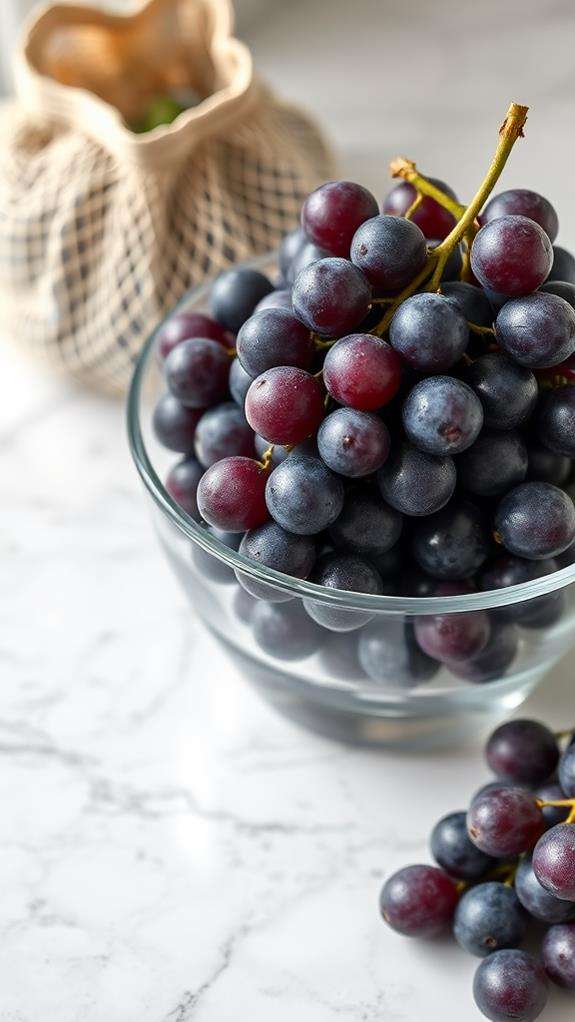
Before storing grapes in your fridge, you'll need to follow several key steps to maximize their freshness. First, don't wash your grapes until you're ready to eat them, as excess moisture can accelerate spoilage. Instead, inspect the bunch carefully and remove any damaged, moldy, or mushy grapes that could affect the others.
You'll want to store your grapes in their original ventilated plastic container or transfer them to a perforated plastic bag that allows for proper air circulation. If you're using the original container, line it with a paper towel to absorb excess moisture. Place the container in your refrigerator's crisper drawer, maintaining a temperature between 30-32°F (just above freezing), as this range provides ideal storage conditions.
Don't store your grapes near strong-smelling foods, as they can absorb odors easily. Additionally, keep them away from the back of the fridge where temperatures might drop below freezing. If you've purchased multiple bags, don't stack them, as this can crush the grapes underneath and lead to premature spoilage. Following these storage methods will help maintain your grapes' freshness and extend their shelf life.
Signs of Fresh Grapes
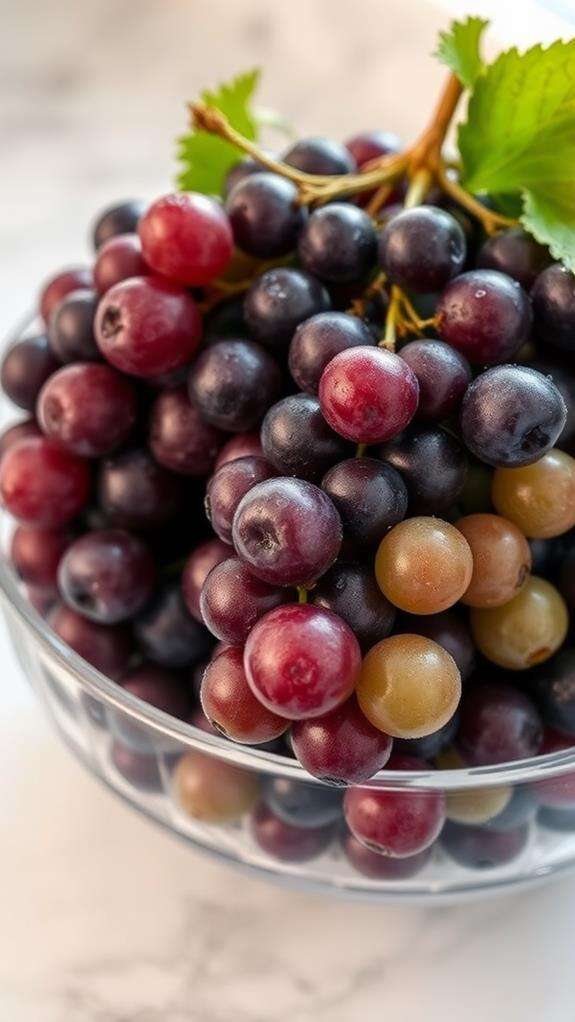
Now that you know how to store grapes properly, you'll want to make sure you're selecting fresh ones to begin with. Fresh grapes display several key characteristics that you can easily identify during your shopping trip.
Look for grapes that are firmly attached to their stems, as loose berries often indicate age or rough handling. The stems should be green and pliable, not brown or brittle. You'll want to check that the grapes themselves are plump and full, with a consistent color throughout the bunch. For green varieties, look for a slightly yellowish hue rather than a pure green color, which can indicate underripeness. Red and purple grapes should have deep, rich coloring without any signs of browning.
When examining the grape's skin, it should be taut and smooth, free from wrinkles, soft spots, or discoloration. A natural whitish bloom coating on the grapes is actually desirable – it's a protective layer that helps preserve freshness. You shouldn't see any signs of mold, which appears as white or gray fuzzy spots, and the grapes shouldn't feel sticky or have any unusual odors.
When Grapes Go Bad
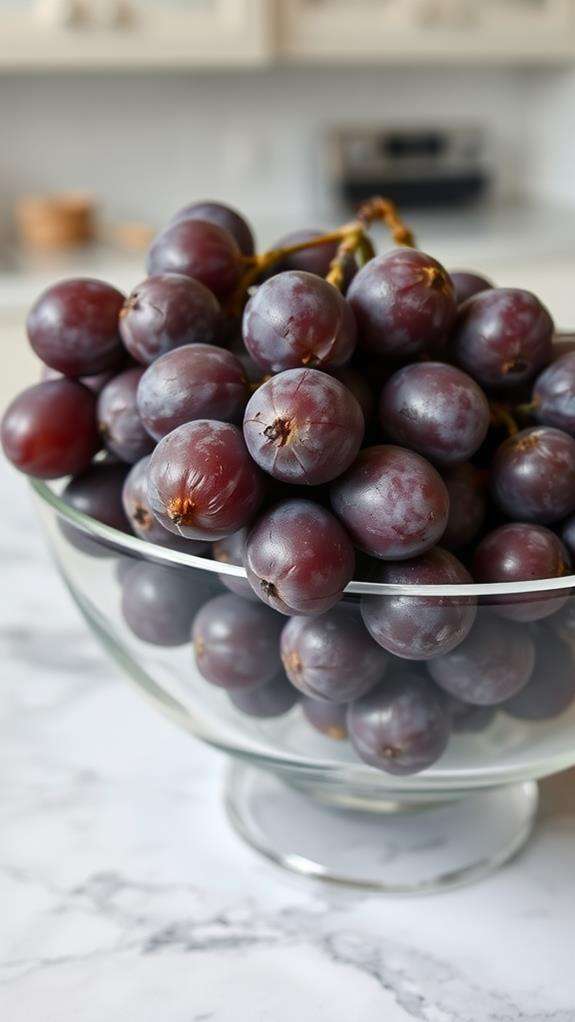
You'll know your grapes have gone bad when you spot fuzzy, white, or gray mold growing on their surfaces, which often appears first at the stem or in areas where grapes touch each other. Changes in color, such as grapes turning brown or developing dark spots, are clear indicators that they're past their prime and should be discarded. When grapes become soft, mushy, or wrinkled instead of maintaining their firm, plump texture, they've spoiled and aren't safe to eat.
Signs of Mold
Most grapes will develop visible signs of mold when they start going bad. You'll notice fuzzy, white or gray spots forming on individual grapes, which can quickly spread to neighboring fruit. These patches often start small but will gradually expand, creating a cotton-like texture that's impossible to miss.
When examining your grapes for mold, you'll want to look for any discoloration that appears powdery or fuzzy, particularly in the areas where grapes connect to their stems. If you spot green or blue-tinted mold, that's a clear indication of spoilage, and you should discard the affected grapes immediately. Don't try to salvage partially moldy clusters, as microscopic spores have likely already spread throughout the bunch.
You might also notice that moldy grapes develop soft, mushy spots beneath the fuzzy growth. These areas may appear sunken or wrinkled, and the skin might split open easily. If you're storing your grapes in a plastic bag or container, condensation can accelerate mold growth, so it is crucial to check them regularly and remove any affected pieces before the problem spreads to the entire batch.
Color Changes Indicate Spoilage
Color changes serve as telltale indicators that your grapes are deteriorating. When your fresh grapes start to lose their vibrant appearance, you'll notice they're evolving from their original bright green, deep purple, or rich red hues to duller, less appetizing shades.
You'll want to watch for brown spots, which typically appear first at the stem attachment point and gradually spread across the grape's surface. Green grapes often develop a yellowish-beige tinge, while purple varieties may show brownish-maroon discoloration. If you're examining red grapes, they'll frequently turn an unappetizing brownish-pink color when they're going bad.
The skin's texture will also change along with the color. You'll notice it becoming slightly wrinkled and losing its characteristic shine. When grapes begin to turn translucent or develop dark patches, they're definitely past their prime. Pay special attention to any grapes showing unusual color patterns or spots, as these could indicate the beginning stages of decomposition. If you spot any grapes in your bunch with these color changes, it's best to remove them immediately to prevent accelerated spoilage of the surrounding fruit.
Soft and Mushy Texture
Beyond visual cues, texture changes are a clear sign that grapes have begun to spoil. When you touch fresh grapes, they should feel firm and plump with a slight give when squeezed. If your grapes have become soft, mushy, or wrinkled, they've likely passed their prime and started deteriorating.
You'll notice that spoiling grapes develop an unpleasant, squishy consistency that's quite different from their original texture. The grape's skin may appear stretched and loose, while the flesh inside becomes increasingly soft and watery. This textural breakdown occurs when the fruit's cell structures begin to collapse, often due to natural aging processes or improper storage conditions. When you press these deteriorating grapes between your fingers, they'll feel distinctly softer than fresh ones, and in severe cases, they might even burst under slight pressure. If you encounter grapes with any of these texture issues, it's best to discard them, as the mushiness typically indicates that harmful bacteria have begun colonizing the fruit. Remember, while slightly wrinkled grapes might still be safe to eat, anything that feels especially soft or mushy should be avoided to prevent potential foodborne illness.
Optimal Refrigeration Temperature
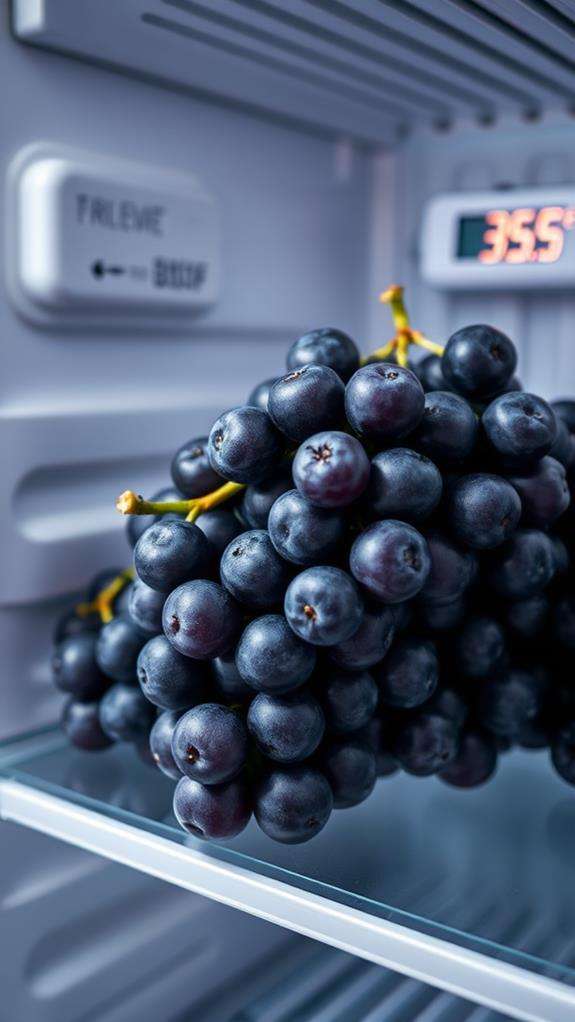
You'll want to store your grapes at a consistent temperature between 32-40°F (0-4°C), which hits the sweet spot for keeping them fresh while preventing freezing damage. Checking your refrigerator's temperature settings daily helps guarantee your grapes aren't exposed to harmful fluctuations that could speed up spoilage. For the most reliable storage conditions, keep a thermometer in your fridge's main compartment and adjust the settings as needed, especially during seasonal changes when your kitchen's ambient temperature might affect the appliance's performance.
Ideal Storage Temp Range
To maximize the shelf life of your grapes, keep them at a consistent temperature between 30-32°F (-1 to 0°C) in your refrigerator. This narrow temperature range provides ideal conditions for grape preservation while preventing freezing, which can damage the fruit's cellular structure and affect both texture and taste.
Understanding temperature control for grape storage involves several key considerations:
- Your refrigerator's temperature fluctuates throughout the day, especially when you're opening and closing the door, so place grapes toward the back where temperatures remain more stable.
- Don't store your grapes in the crisper drawer if it's warmer than 32°F, as many crisper drawers maintain slightly higher temperatures for leafy vegetables.
- If your fridge has multiple shelves, the middle shelf typically maintains the most consistent temperature, making it perfect for grape storage.
- Monitor your refrigerator's temperature with a thermometer to verify it doesn't drop below 30°F, which could cause freezing.
While some refrigerators might struggle to maintain such precise temperatures, you'll want to keep your grapes as close to this range as possible. Modern fridges often have digital temperature controls that make maintaining these specific conditions much easier.
Monitor Fridge Settings Daily
Regular monitoring of your refrigerator's settings ensures your grapes receive consistent ideal temperature conditions. You'll want to check your fridge's temperature display at least once daily, preferably in the morning before frequent door openings begin. If your refrigerator doesn't have a built-in thermometer, invest in an inexpensive refrigerator thermometer to guarantee accurate readings.
Make it a habit to inspect the temperature settings whenever you're storing fresh grapes. The digital display or dial should consistently show between 32°F and 36°F (0°C to 2°C), with 34°F (1°C) being the sweet spot for grape storage. You'll need to adjust the temperature control if you notice fluctuations outside this range, as variations can greatly impact grape longevity. Keep in mind that different areas of your refrigerator maintain slightly different temperatures, so place your grapes in the crisper drawer where temperature stability is typically better. If you notice condensation building up on the grape container, it's a sign that your temperature settings might be too low or that humidity levels need adjustment. Document any temperature changes you observe to help maintain ideal storage conditions.
Washing and Drying Tips
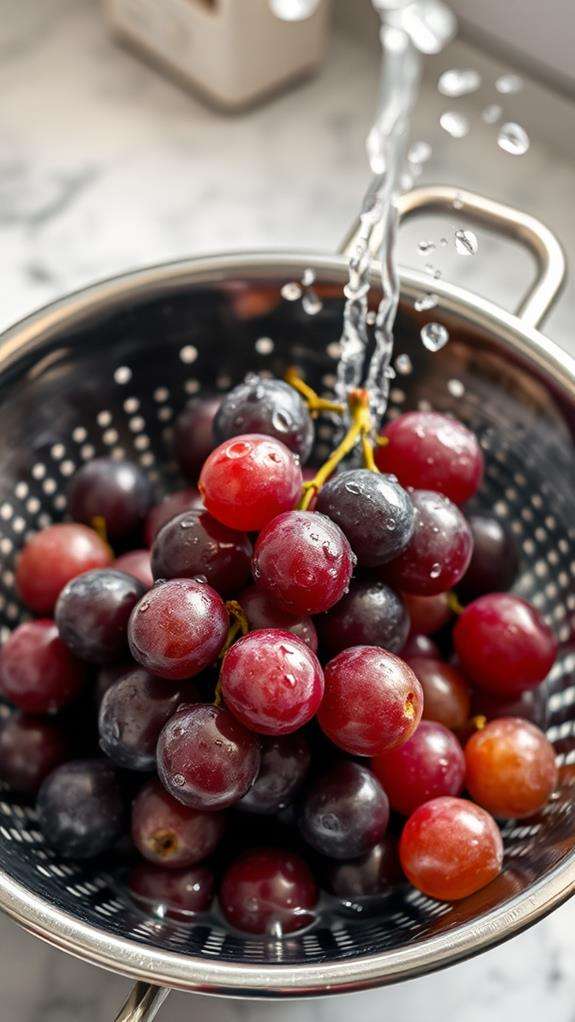
Before storing grapes in your fridge, proper washing and drying techniques can greatly extend their shelf life. You'll want to make sure you're removing any surface contaminants while avoiding excess moisture that could promote mold growth. The process isn't complicated, but it requires attention to detail and the right timing.
- Don't wash your grapes immediately upon bringing them home if you're not planning to eat them right away; moisture during storage can accelerate spoilage
- When you're ready to wash them, use cold water and a gentle fruit wash solution, or create your own by mixing one part white vinegar with three parts water
- Remove any damaged or moldy grapes from the bunch, as they'll cause neighboring grapes to deteriorate faster
- Pat the grapes thoroughly dry with paper towels or use a salad spinner lined with paper towels for better moisture removal
If you're planning to store your grapes for an extended period, you'll want to keep them unwashed in their original ventilated packaging. When you're ready to consume them, that's the time to wash and dry them properly, guaranteeing peak freshness and food safety.
Extending Grape Shelf Life
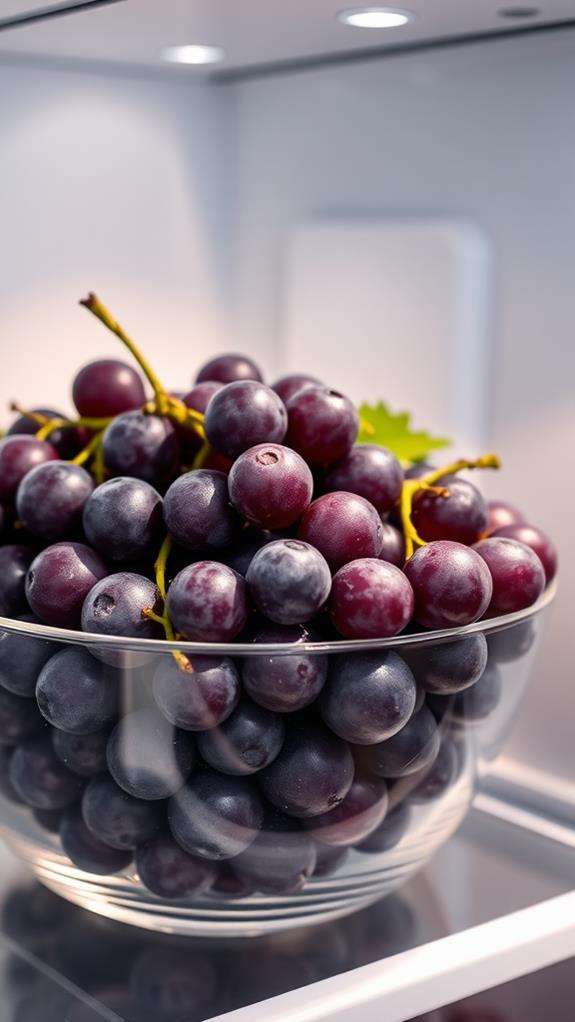
Smart grape storage techniques can considerably extend their shelf life beyond the typical 1-2 weeks. You'll want to focus on maintaining ideal temperature and humidity levels while preventing moisture buildup that can lead to mold growth.
| Storage Method | Expected Shelf Life |
|---|---|
| Room Temperature | 2-3 days |
| Regular Fridge Drawer | 1-2 weeks |
| Ventilated Container | 2-3 weeks |
| Paper-Lined Container | 2-3 weeks |
| Vacuum-Sealed Bag | 3-4 weeks |
To maximize your grapes' longevity, you'll need to store them at 32-36°F with 85-95% humidity. Don't remove them from the stem until you're ready to eat them, as the stems help maintain moisture balance. If you notice any spoiled grapes, remove them immediately to prevent spreading decay to the rest of the bunch.
You can also try placing your grapes in a perforated plastic bag with a few paper towels to absorb excess moisture. This method helps maintain proper airflow while preventing condensation buildup. Remember to check your stored grapes regularly and remove any that show signs of deterioration, which will help protect the remaining fruit.
Best Storage Containers
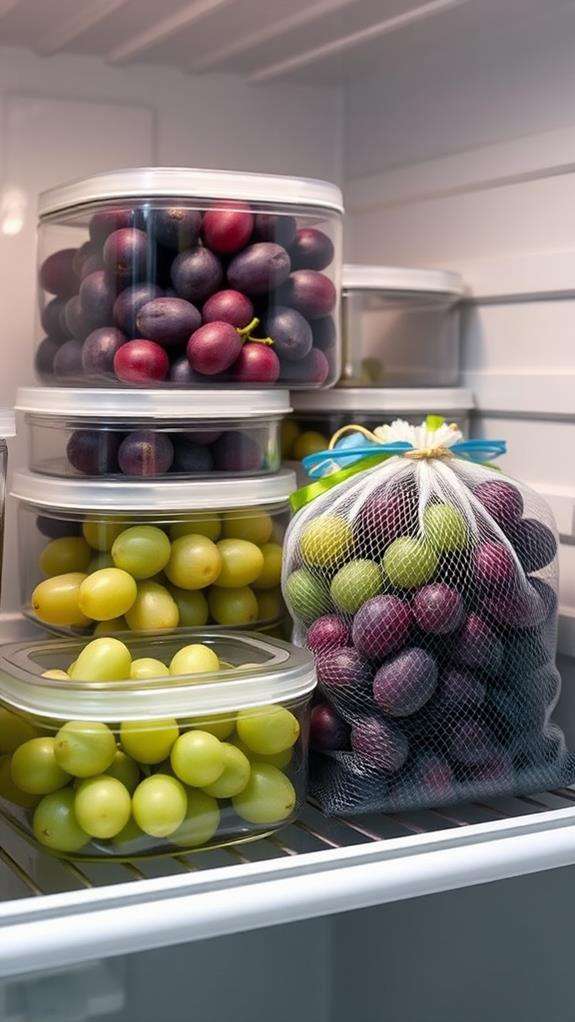
Selecting the right container makes a significant difference in keeping your grapes fresh and crisp. When you're choosing storage options for your grapes, you'll want to take into account containers that provide adequate ventilation while maintaining proper humidity levels. The original plastic bag from the store isn't your best choice, as it can trap excess moisture and accelerate spoilage.
- Perforated plastic containers: These specialized produce containers have tiny holes that allow for ideal airflow, preventing condensation buildup while maintaining humidity.
- Mesh produce bags: They're excellent for grape storage because they promote air circulation and let you easily monitor your fruit's condition.
- Glass containers with ventilated lids: These provide sturdy protection while allowing moisture to escape, plus they're environmentally friendly.
- Original clamshell containers: If properly cleaned and dried, these can be reused, as they're designed specifically for grape storage.
You'll want to avoid airtight containers, as they trap ethylene gas, which speeds up ripening. Whatever container you choose, make sure to remove any damaged grapes before storage, as they can cause nearby grapes to deteriorate more quickly. Remember to leave some space for air circulation around the fruit.
Before Refrigerating Your Grapes
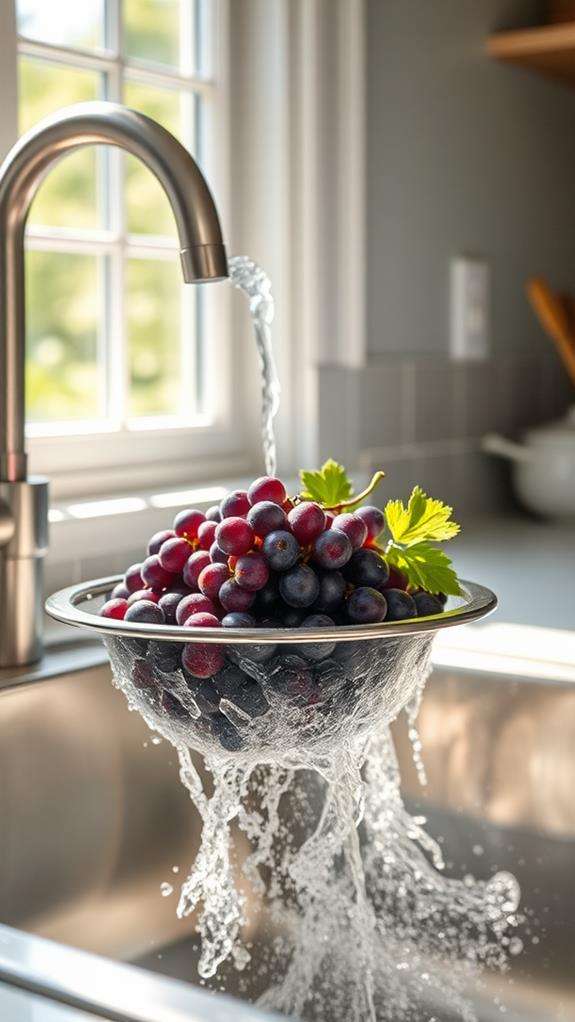
Proper preparation of your grapes before refrigeration can extend their shelf life by several days. Before you store your grapes, you'll need to carefully inspect them for any signs of mold, bruising, or damage. Remove any grapes that show these issues, as they'll accelerate spoilage of the surrounding fruit through a process called oxidative degradation.
Don't wash your grapes before storing them in the refrigerator, as excess moisture promotes bacterial growth and mold formation. Instead, keep them dry and unwashed until you're ready to eat them. You should also leave the grapes attached to their stems, which helps maintain their freshness and prevents premature dehydration at the attachment points.
If you've purchased your grapes in a perforated plastic bag, you can keep them in this container, but make sure to remove any paper or cardboard packaging. Gently pat the grapes with a clean, dry paper towel to remove any surface condensation or residual moisture from the store's produce misters. This step is essential for preventing premature spoilage and maintaining ideal freshness throughout their storage period.
Common Storage Mistakes
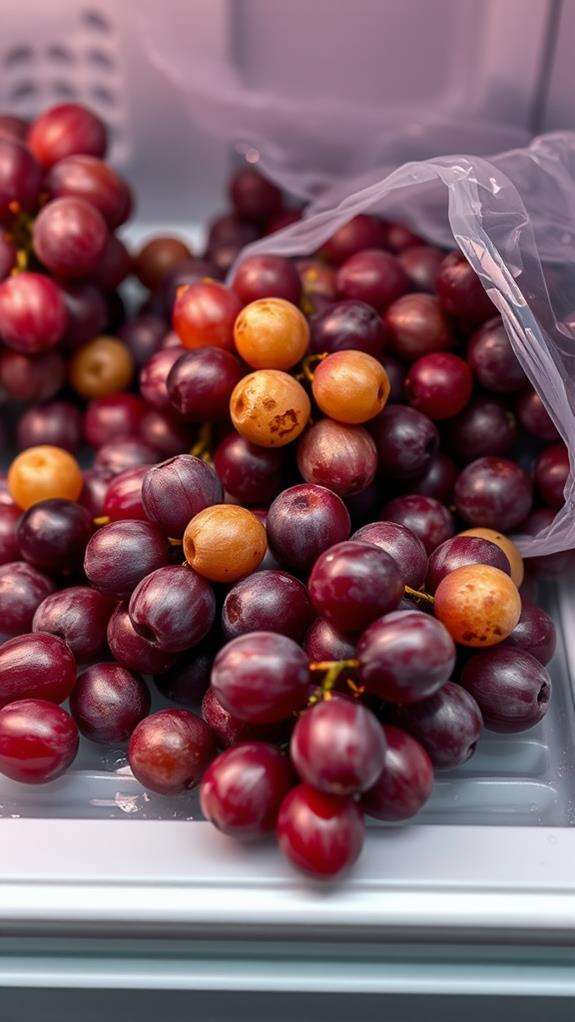
While proper preparation sets the foundation for grape storage, many people unknowingly make mistakes that reduce their grapes' shelf life. You'll want to avoid these common errors to maximize freshness and prevent premature spoilage of your fruit.
- Storing grapes near ethylene-producing fruits like apples, bananas, or pears – these fruits release gases that accelerate ripening and can cause your grapes to deteriorate faster
- Washing grapes before storage – moisture encourages mold growth, so you shouldn't rinse them until you're ready to eat them
- Keeping grapes in the original plastic grocery store bag – these create excess moisture and don't allow proper air circulation, leading to faster spoilage
- Placing grapes in the back of the refrigerator where it's too cold – temperatures near freezing can damage the fruit's cellular structure
You'll also want to avoid storing grapes in the crisper drawer's high-humidity setting, as this environment can trap moisture. Instead, use the low-humidity setting and keep them in their original ventilated container or transfer them to a perforated plastic bag. Remember to check your grapes regularly and remove any that show signs of decay.
Frequently Asked Questions
Can Frozen Grapes Be Refrozen After Thawing?
Picture those plump, glistening grapes you've just thawed – unfortunately, you shouldn't refreeze them. When you freeze grapes, ice crystals form inside their cells, and thawing breaks down their structure. If you refreeze them, you'll end up with mushy, unappetizing fruit that's lost its texture and flavor. Plus, there's a food safety concern, as repeated temperature changes can promote bacterial growth. It's best to use thawed grapes immediately or keep them refrigerated.
Do Different Colored Grapes Have Different Shelf Lives?
Different colored grapes don't greatly vary in their shelf life when stored properly. You'll find that green, red, and black varieties all typically last 7-14 days in the refrigerator. However, each variety's firmness and sugar content might slightly affect its longevity. For example, green grapes often have thicker skins and lower sugar content, which can make them a bit more resilient, but the difference isn't substantial enough to impact your storage planning.
Why Do Some Grapes Taste Fizzy in the Fridge?
Like tiny bottles of champagne gone wrong, fizzy grapes are actually fermenting in your fridge. When you're storing grapes too long, yeasts naturally present on their skin begin converting the fruit's sugars into alcohol and carbon dioxide, creating that bubbly sensation. You'll notice this happens especially if your grapes are bruised or damaged. It's best to discard these grapes, as they've begun the natural decomposition process.
Can You Store Grapes and Other Fruits Together?
You'll want to be careful when storing grapes with other fruits, as many fruits produce ethylene gas, which can speed up ripening and spoilage. While grapes don't produce much ethylene themselves, they're sensitive to it. Keep them separate from high ethylene producers like apples, pears, and bananas. You can safely store them with other low-ethylene fruits like berries and citrus, but it's best to keep grapes in their own ventilated container.
Does Removing Grapes From Their Stems Make Them Spoil Faster?
Like precious gems in a vault, your grapes will stay fresher when left on their stems. When you remove grapes from stems, you're actually breaking their natural protective seal, which speeds up deterioration. You'll notice they'll get softer and spoil more quickly. The stems help regulate moisture and provide nutrients even after harvesting. That's why it's best to only remove grapes from their stems when you're ready to eat them.





